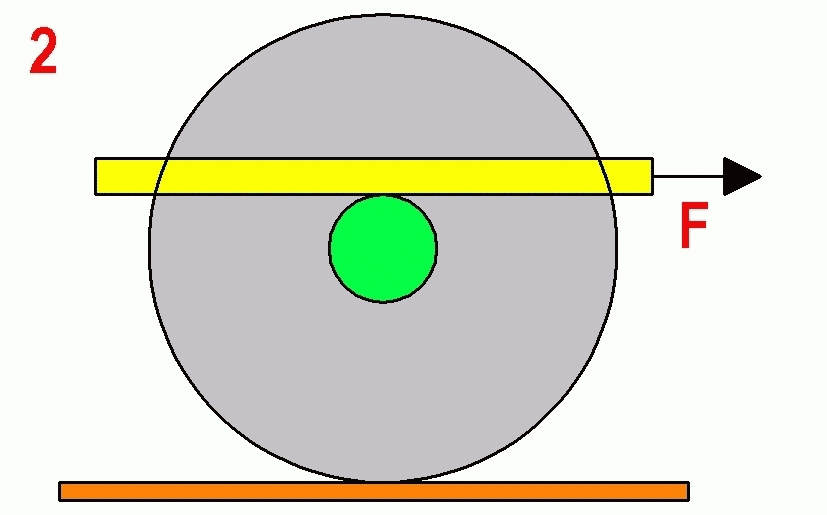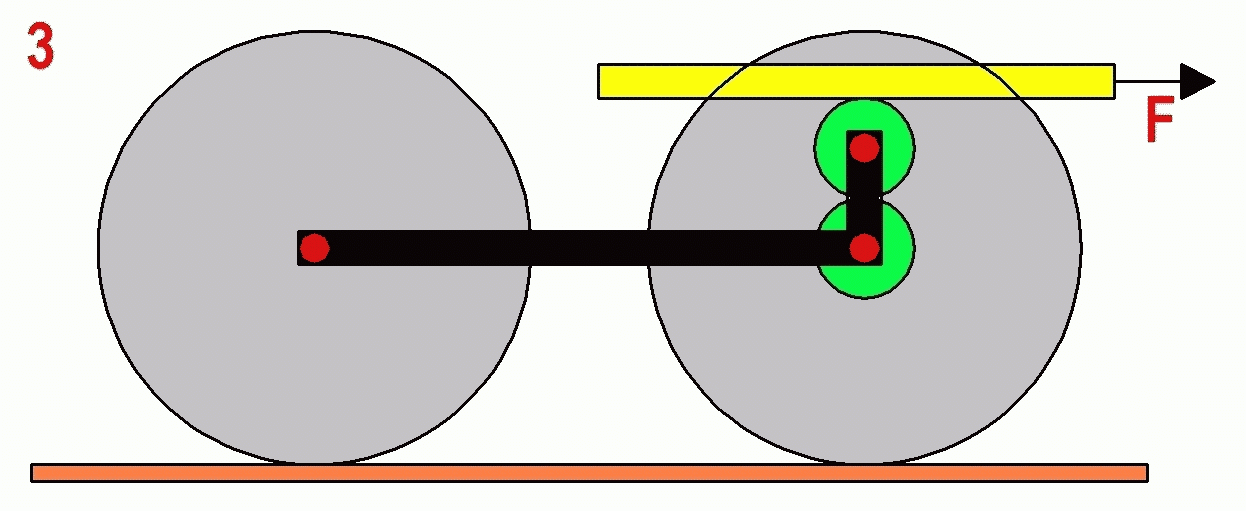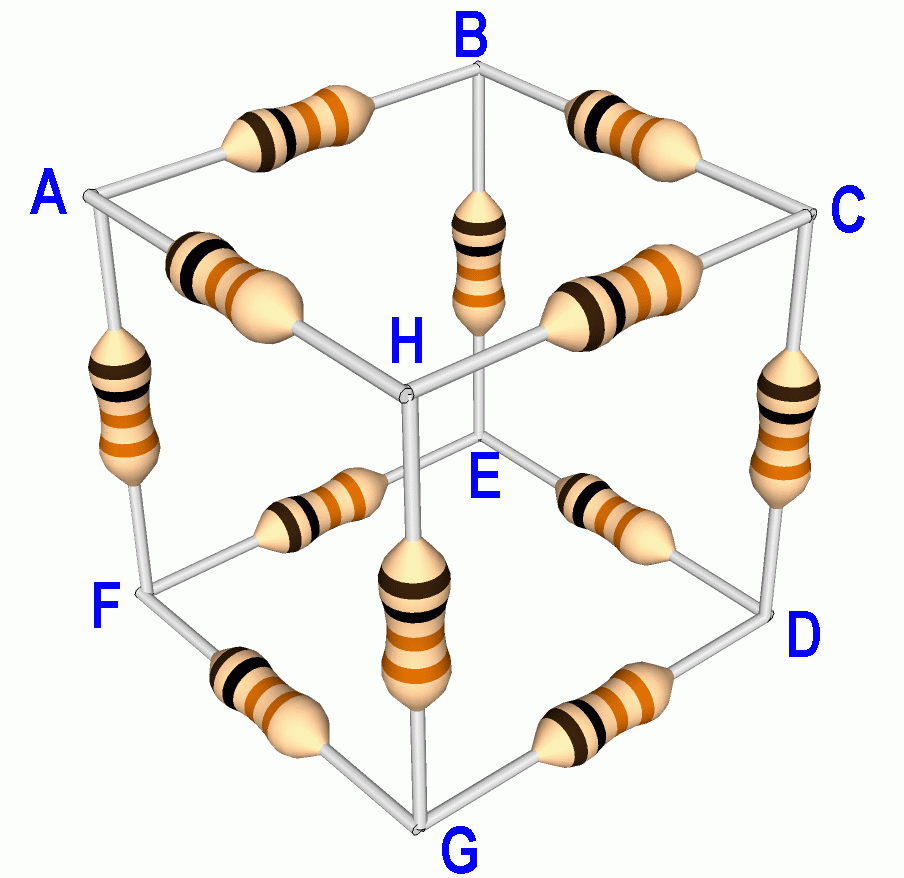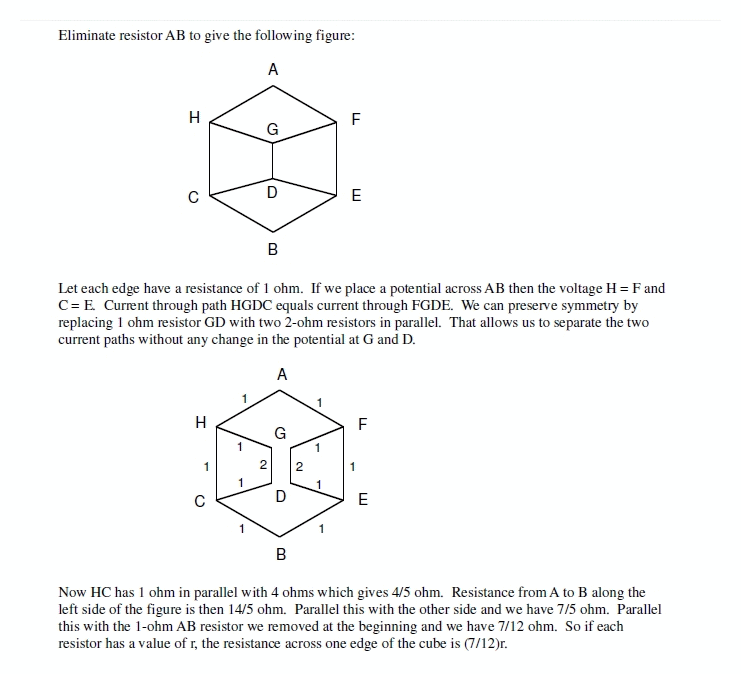Answers to
Challenging Physics Problems.
Collected, edited and extended by Donald Simanek.
1. Just rolling along.
 |
1. Figure 1 shows a wheel (grey) with a central hub (green). It can roll freely on the flat, level tabletop. A beam (yellow) is pressed on the bottom of the hub and pulled to the right with force F. The radius of the large wheel is 13, the radius of the hub is 3. The beam, hub, and wheel all roll without slipping.
As the wheel rolls a distance x, it rotates through angle x/R1 (in radians).
For simplicity let us consider an angle of one radian.
The beam moves in the same sense as the grey wheel and the green axle rolls through the same angle.
So the beam moves R2 length with respect to the green axle.
The beam therefore moves a distance R1-R2 = (13-3) = 10.
The wheel rolls through a distance 13.
So the wheel moves 13/10 = 1.3 times as far as the beam,
in the direction the beam is pulled.
 |
2. Figure 2 shows a similar situation, but the beam rests on the top of the hub. Same questions.
 |
3. Figure 3 shows another friction (or geared) roller contacting the hub. A beam rests on the top of it. Same questions.
None of these give motion in a direction opposite to F.
 |
4. Now, can you devise a mechanical cart that will travel opposite to the direction of the applied force, slower than the agent applying that force moves?
This one (4) moves the wheel slower than the agent applying the force F, and in the opposite direction, as required.
5. Now, can you devise a mechanical cart that will travel opposite to the direction of the applied force, faster than the agent applying that force moves?
2. The Terrible Resistor Tetrahedron.
 |
This electrical network contains five equal resistors and one resistor that differs markedly from the others. How can you identify the different resistor by using only an standard ohm meter with the fewest measurements? What is the minimum necessary number of measurements in the worst case? In the best case (if you were lucky)?
You may not disconnect, short out or unsolder the resistors. You may not connect anything other than a standard ohm meter. Describe your method and reasoning. The four junctions are labeled for convenience.
Four ohmmeter measurements are required, no more. However, you will sometimes "get lucky" and find the oddball with only three measurements.
This problem was sent to me over ten years ago by a student in Pakistan who said it had been a homework assignment in his physics class. I have not seen the problem elsewhere. At that time I think we solved it. In the meantime I forgot my solution, but fortunately did recall the problem itself.
3. The classic resistor cube.
 |
Twelve identical resistors of resistance r are soldered together in a cubic network.
(a) What is the resistance measured with an ohmmeter between A and C?
(b) What is the resistance between A and B?
(c) What is the resistance between A and D?
Give all answers in terms of r.
Draw a square with corners ABCH. Draw a smaller square within it labeled FEDG. Connect AF, BE, CD, HG. Something like this:
A_______B |\ /| | \___/ | | |F E| | | |___| | | /G D\ | |/_____\| H CWe've squashed the cube onto a plane without disturbing the topology of the network. This makes it easier to deal with this conceptually.
To find the resistance AC the ohmmeter puts a current between them. Call it I.
Let the individual resisance values be r.
The symmetry tells us that BE and GH have no current. Remove them. Now we have three parallel branches between BC.
One branch, ABC has resistance 2r. So does the branch AHC.
The remaining branch has FED in parallel with FGD. It's resistance is r.
So the inner branch has resistance 3r.
Then 1/R = 1/2r + 1/2r + 1/3r, and then R = (3/4)r.
(b) RAB = (7/12)r. This one is a stinker. Across any one resistor, say AB, we get no obvious symmetries to simplify the solution. But, there's an interesting method. Start with a simpler, symmetric circuit and add things one at a time to build up the original circut.
Matt Parker of San Diego, CA, was the first to submit an insightful solution, so we reproduce it here:

(c) The resistance corner to corner between A and D is (5/6)R.
Solution: Taking advantage of symmetries: The tricks we used above are not available for this network. Back to basics.
The current I into node A splits into three equal parts I/3.
The current I/3 into node B splits into two equal parts I/6.
Two currents I/6 into node C add to a current I/3 in resistor CD.
If the potential across AB is V, then the potential across BC is V/2 and the potential across CD is V, by Ohm's law.
The potential A to D is then 5/2 V. (The sum of potentials AB, BC, CD).
I/3 = V/R where R is one resistor. So I = 3V/R and R = 3V/I.
The resistance of the cube from A to D is therefore R(corner to corner) = (5/2)V/(3V/R).
So R(corner to corner) = (5/6)R.
We are implicitly using Kirchoff's laws: (1) The sum of all currents at a node is zero. Be consistent with signs. (2) The sum of all potentials along a closed path is the sum of the potentials across the segments of the path.
There is no way to reduce this to series and parallel combinations.
Any two junctions are adjacent, and by symmetry the resistance measured between any pair will be the same. Connect the ohm meter between B and C. It puts a current I into B and out C. We immediately see that there will be no current in resistor BD, because of the symmetry. So remove BD and nothing changes. Now we have resistor AB and AC in series and that combination in parallel with resistor BC. Let the resistance of each resistor be designated r.
4. The classic resistor pyramid.
 |
Solder six equal resistors of size r into the form of a equilateral pyramid.
The result will be a network just like that shown flattened in problem 2 above.
What is the resistance of the pyramid between any two junctions in terms of r?
The resistance of AB and AC in series is 2r. The resistance between BD and DC is also 2r.
So, designating the resistance between B and C as R, the voltage between B and C as V, and the current into B as I, we have V = IR.
By the formula for parallel resistors we have 1/R = 1/r + 2/(2r) = (2+2)/2r = 2/r, so R = r/2.
5. Where on Earth?
Where on the surface of the earth could you travel 1 mile south, 1 mile east and one mile north and end up at your starting point?One obvious answer is "the North Pole".
But let's look at the region near the South Pole. In the diagram below, the black dot represents the South Pole. A circle of circumference C has radius R = C/(2π). Begin at A, a distance (R + 1 mile) from the South Pole. Travel 1 mile south and you are at point B, a distance R from the pole. Then 1 mile east and you have gone once around the circle, back to point A. Another mile of travel north and you are at the starting point, A. Of course, there are an infinite number of starting points that would do this. They all lie on a circle of radius (1/2π + 1) mile centered on the South Pole.

Now if you began (R/2 + 1 mile) from the South Pole you could meet the conditions of the problem, your Eastward journey taking you twice around the circle. Again, there are an infinite number of starting points meeting this condition.
But we also see there would be an infinite number of starting distances from the South Pole that would also satisfy the conditions of the problem. They are (1/2nπ + 1) miles from the South Pole, where n is any integer.
By the way, the diagram shows a classic visual illusion. If you were asked "Which is longer, the straight line AB, or the circumference of circle B?", you would probably judge the straight line to be much longer. Actually the two are nearly equal in this diagram. This simple visual illusion is seldom mentioned in books about illusions.
6. Walking the dog.
Jane is walking her dog, spot. She sees her friend, Dick, walking toward her along the same long, straight road. Both Dick and Jane are walking at a liesurely 3 mph. When Dick and Jane are 600 feet apart, Spot runs from Dick to Jane, turns and runs back to Dick, and then back and forth between them at constant speed of 8 mph. Dick and Jane both continue walking toward each other at a constant 3 mph. Neglecting the time lost each time Spot reverses direction, how far has Spot run in the time it takes Dick and Jane to meet?Dick and Jane are initially 600 feet apart. Each walks half that distance, or 300 feet, to meet. This takes t = d/v = 300/3 = 100 time units. We are using "mixed" units here, distance in feet, speed in miles/hour, and time in (foot-hours)/mile. But who cares about the time units so long as we are consistent? In that time the dog travels d = vt = 8×100 = 800 feet.
Using mixed units avoids a unit conversion from miles/hour to ft/second, making the computation easier to do in one's head. We weren't asked to find the time, so it drops out of the calculation. In fact, a better approach is to do the algebra first, then insert numbers, which is nearly always a good strategy. We also weren't asked to calculate the ever-decreasing distances for each of Spot's runs between Dick and Jane. t = d/v where d is the distance Dick and Jane walk, and v is their speed.
D = Vt where D is the distance Spot runs and V is Spot's speed.
Then D = Vd/v = 8×300/3 = 800 ft.
Answers to the other problems.
I'm continually adding problems to this collection. Some don't have tidy answers here yet, but preliminary answers can be seen by using your browser's "reveal source code" option on the "Challenging Physics Problems" page.
Return to Donald Simanek's page.
Return to the top of this document.
Return to Challenging Physics Problems.
Return to The Museum of Unworkable Devices' Main Gallery.